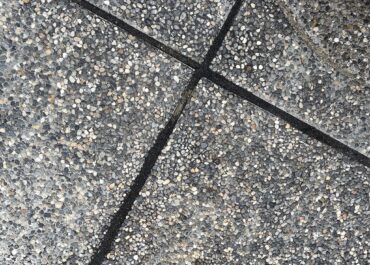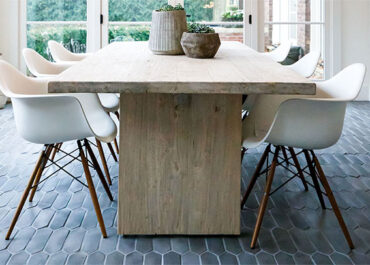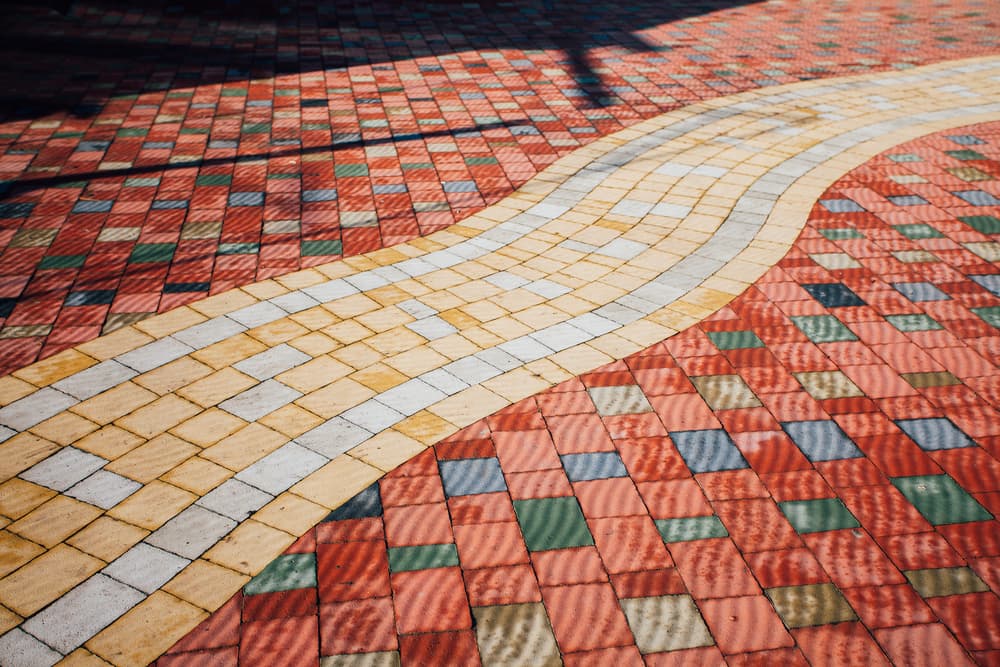
The hardscape industry is full of wonders. In case you don’t know, there’s a paving stone for every type of aesthetic – and we’re not talking about materials or shapes only. Colors are a big feature to look for nowadays; for many homeowners, it’s the sole selling point of pavers, embracing a wide array of tones and design capabilities. If you’re here, you’re probably considering every possibility available when it comes to colored pavers. Which one is the right for you, in the end?
Well, before making a permanent choice, it’s best to look at all the options offered by the American market and narrow them down from there. In this guide, we’ll go over the five most popular paving stones – concrete, brick, porcelain, travertine, and limestone – and give you an overview of the colors they come in.
Don’t miss: All About Remodel Coping in Paver Projects
Colored pavers by material
In the hardscape industry – regarding paving stones, in particular, our main focus here – various colors are commonly used to conceive a wide range of appearances. The main ones include the neutral trio of white, black, and gray, as well as shades of red, beige, and brown.
When choosing paver colors, select tones that harmonize with the area. After all, units a couple of shades lighter than the color of the house or building do not compete for attention. Consider factors like:
- Where the sun hits;
- How long it stays sunny in that area;
- How much shade is being cast in that area;
- If you want to make it look larger or smaller;
- If you want to create a particular mood;
- If there are existing colors that need to stay.
That said, you can get a better idea of the intricacies of colored pavers by segregating materials. Check out a brief guide on what each of these paving stones can offer your home:
Porcelain pavers

- Gray: Gray porcelain pavers offer a modern and versatile look by creating a neutral backdrop and allowing for other elements to pop into the design. Suitable for contemporary patios, walkways, and outdoor seating areas. It pairs well with vibrant furniture and landscaping.
- Beige: On the other hand, beige porcelain exudes warmth and sophistication, making outdoor spaces feel inviting and timeless. Ideal for creating elegant, Mediterranean, or coastal-inspired outdoor areas – including pool decks and courtyard patios.
- White: White porcelain pavers are classic, known for their clean and crisp appearance, and they can be used to create modern and minimalist outdoor designs. They offer a sleek and contemporary look while brightening up outdoor spaces, being often chosen for applications like patios, pool decks, rooftop gardens, and other outdoor areas where a bright and open feel is desired. Their non-porous nature and resistance to stains make them a practical choice for various settings.
Brick pavers

- Red: Red brick brings a classic and timeless charm to outdoor spaces, so it’s suitable for traditional or colonial aesthetics. Often used for walkways, driveways, and garden paths, especially in historic or heritage-inspired designs.
- Brown: Brown bricks are often chosen for a more rustic and natural appearance. They can range from warm, reddish-brown to cooler, gray-brown shades that really drive home the down-to-earth feeling.
- Gray: Now, gray bricks have a modern and contemporary look. They come in various gray tones, from light to dark, and are often used for sleek and industrial-style designs.
Concrete pavers

- Gray: Gray concrete pavers may seem plain but they offer a clean and contemporary appearance, complementing most of the architectural styles in the U.S. They are versatile for modern patios, urban landscapes, and commercial settings.
- Beige: Beige or tan concrete pavers provide a warm and inviting appearance, making them suitable for various design styles, including Mediterranean and rustic.
- Black: Charcoal or black concrete pavers are selected for modern, serious, and contemporary designs – offering a sleek and sophisticated appearance for businesses and commercial buildings above all.
Travertine pavers
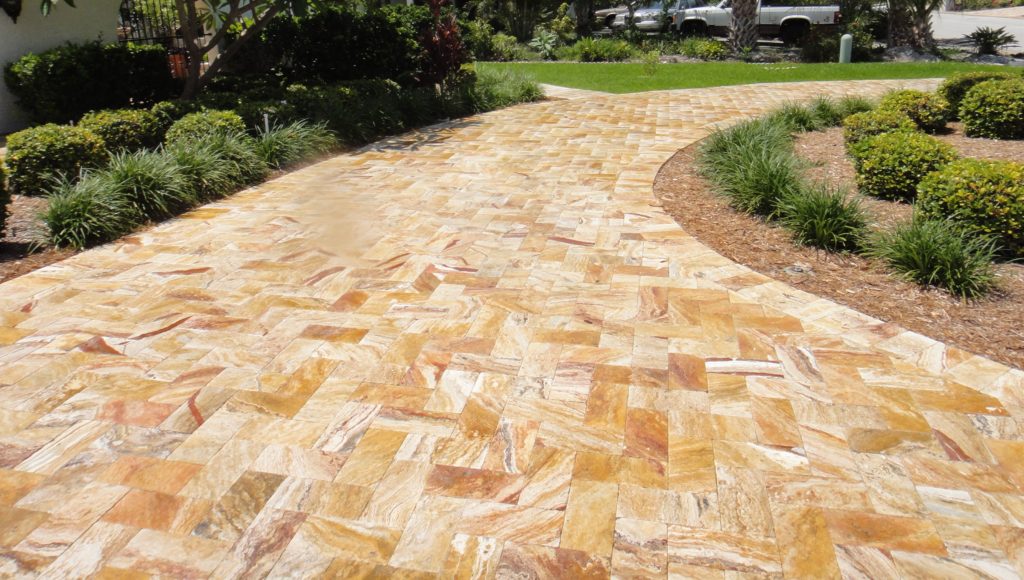
- Beige: Beige travertine exudes an understated elegance and a natural feel, making outdoor spaces feel tranquil. Well-suited for Mediterranean, rustic, or spa-like designs in areas like pool decks, outdoor kitchens, and courtyards.
- Walnut: Walnut or brown travertine has deeper and warmer brown tones, which add a rich, earthy quality to hardscape designs.
- Gold: Gold travertine is quite rare – it features vibrant golden hues that create a bold and luxurious look in outdoor settings, especially when combined with blue.
Limestone
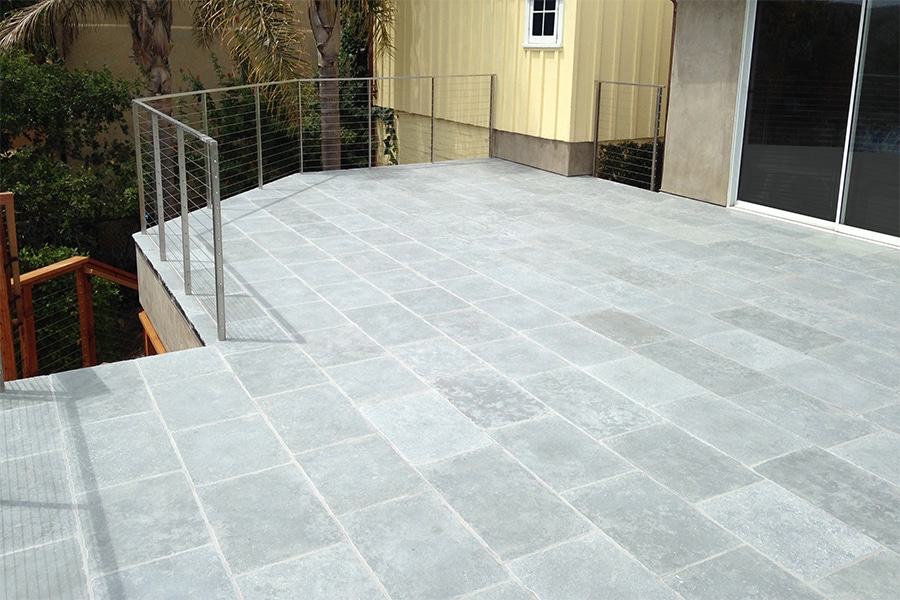
- White: Just like porcelain, white limestone pavers create a clean and sophisticated appearance, providing a sense of luxury. Great for contemporary and upscale designs, such as modern garden pathways, high-end outdoor dining areas, and formal garden settings.
- Beige: Beige limestone combines warmth and versatility, offering a timeless and natural look. Suitable for a wide range of outdoor spaces, including patios, terraces, and garden walkways in both traditional and modern settings.
- Gray: Gray limestone lends a contemporary and cool aesthetic – making outdoor areas feel chic and sleek – so it’s ideal for modern landscapes, minimalist designs, and urban gardens.
Advantages and disadvantages of each color
Now that you know what to expect from each product, it’s time to further consider the options available to you. In spite of all the design preferences you may have to create a visually pleasing environment, some additional factors should be taken into account when picking a color for your next project.
Below, we’ve listed the main characteristics of the aforementioned colored pavers – and hopefully, you can use them as a buying guide with no margin for mistakes.
Gray
- Versatile and complements various architectural styles;
- Creates a modern and neutral backdrop for other design elements;
- Hides dirt and stains well;
- May feel cold and less inviting in some settings;
- May show salt stains more visibly in snowy climates.
Red
- Classic and timeless appearance;
- Adds warmth and traditional charm;
- Hides minor imperfections well;
- Limited versatility for contemporary designs;
- May fade over time due to sun exposure.
Beige
- Warm and inviting, suitable for various design styles;
- Blends well with natural surroundings;
- Resists fading and remains cool underfoot;
- May show stains and dirt more readily;
- Less dramatic and contrasting than some other colors.
Brown
- Provides an earthy and rustic appearance;
- Camouflages dirt and stains effectively;
- Cozy and inviting in outdoor spaces;
- Limited modern or formal design applications;
- Can appear heavy in some settings.
Black
- Modern and sleek appearance;
- Ideal for contemporary and minimalist designs;
- Enhances contrast with other design elements;
- Absorbs heat and may become hot under the sun;
- Dust and debris may be more visible.
White
- Crisp and clean appearance, making spaces feel open and bright;
- Ideal for modern and minimalist designs;
- May show stains, dirt, and discoloration more visibly;
- May require more frequent cleaning and maintenance.
Further tips for matching colored pavers
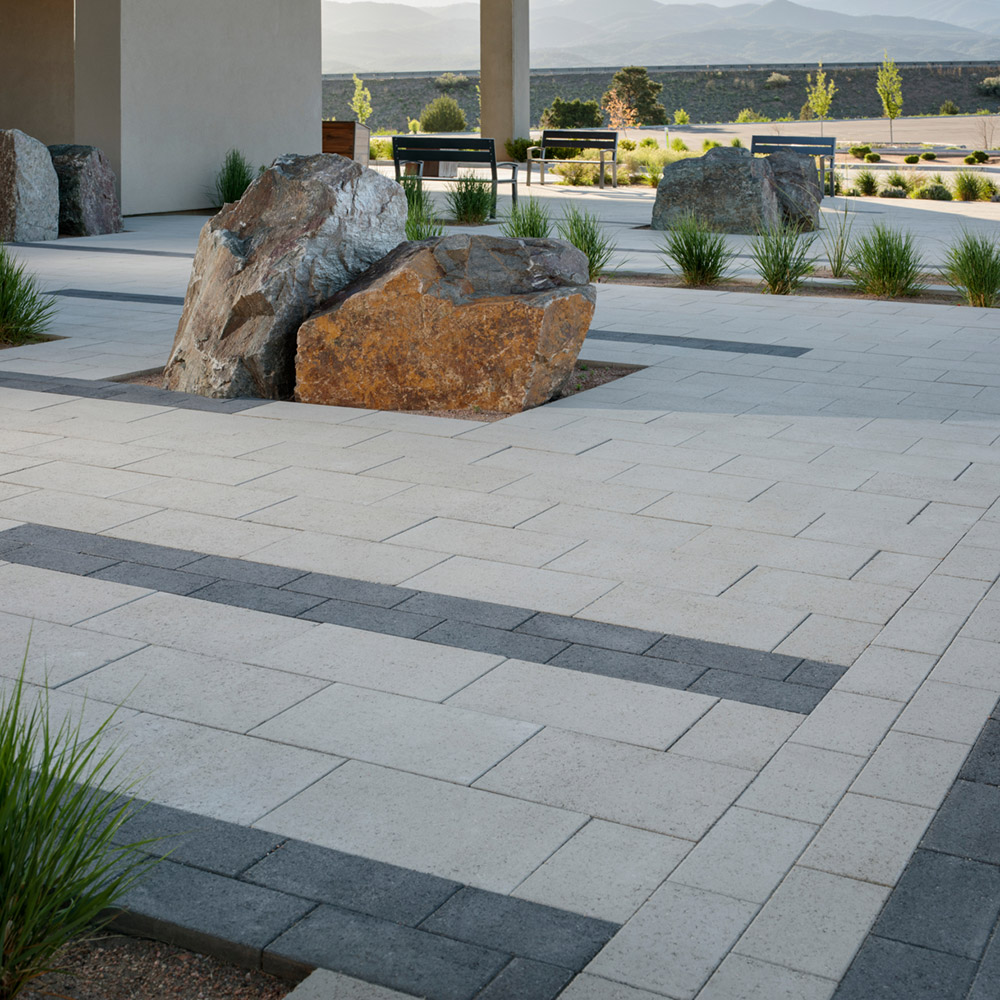
As you can see, choosing the right color is crucial to achieving a harmonious visual for the project you’ve been picturing. So, to help you in this mission, consider the following tips when selecting paver colors that complement your outdoor space:
- Consider the color of your roof: If your home has a specific roof color, take it into account when choosing your paver colors. For example, if you have a roof with warm tones like terracotta or brown, consider selecting paver colors that harmonize with those hues. This coordination ensures a cohesive and unified look for your entire property;
- Take curb appeal into account: Of course, the curb appeal of your home plays a vital role in creating a welcoming first impression. Consider the overall color scheme of your property, including the exterior walls, landscaping elements, and other features. Choose paver colors that complement or contrast with these existing colors to create a visually appealing and cohesive appearance – this might even increase your house’s resale value in the future.
- Monotone pavers for subtle elegance: If you prefer a more understated and minimalist look, opt for monotone pavers – because they come in a single color or shade of the same hue, offering a sleek and refined aesthetic. Monotone works well in contemporary designs and allows other elements in your outdoor space, such as furniture or vegetation, to become the focal point.
- Multicolored pavers for visual interest: For a more vibrant and eye-catching design, consider using multicolored pavers. This design pattern features a blend of various complementary colors, adding depth and visual interest to your hardscape. Multicolored pavers are an excellent choice when you want to create intricate patterns, borders, or artistic focal points.
- Observe samples in natural lighting: When selecting Belgard paver colors, it’s essential to view physical samples under natural lighting conditions. The appearance of colors can vary depending on lighting conditions, so it’s crucial to see how the pavers will look in your specific environment. This step ensures that you make an informed decision based on how the colors interact with your outdoor space.
Can you paint pavers?
The short answer is no. Painting pavers is not worth your time – much less your budget, which you can spend hiring a professional team for a full renovation of your outdoor space instead. It doesn’t matter how you look at it – if you’re looking for a lasting and low-maintenance solution, it may be preferable to choose pavers in the color or style that suits your design from the outset rather than relying on paint.
But why, you may ask?
First of all, painted pavers are susceptible to wear and tear, especially in high-traffic areas. They may require regular touch-ups or repainting over time – which means a higher demand for maintenance, including periodic cleaning, sealing, and repainting, to maintain their appearance and integrity.
Moreover, paint can alter the texture of the paver surface, making it smoother and potentially more slippery, which could be hazardous in wet conditions. Proper surface preparation is critical for paint adhesion – and if the pavers have any existing dirt, efflorescence, or sealants, the paint may not adhere well, also leading to peeling or chipping.
Finally, once you paint your pavers, it can be challenging to restore them to their original state. Stripping paint from pavers can be a labor-intensive process, and depending on the type of paint used, there may be environmental considerations regarding the release of harmful chemicals into surrounding nature.
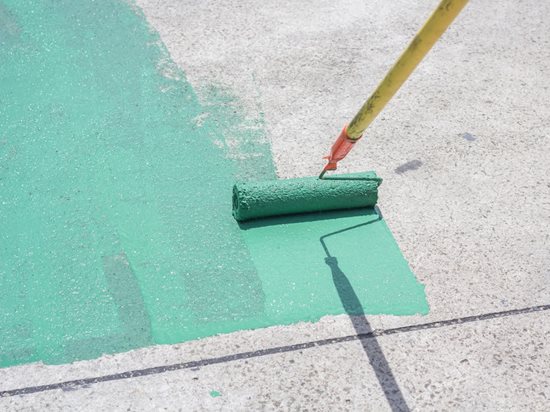
Therefore, it’s essential to consider your long-term goals and whether you’re willing to invest the time and effort required for ongoing maintenance. If you decide to proceed, just make sure to follow the manufacturer’s recommendations for surface preparation, type of paint, and sealing to maximize the durability and longevity of the painted pavers.
Get high-quality colored pavers with us!
As a branch of Eagle Stones, our team specializes in paver supply and installation around the county of Sarasota and Manatee, Florida. In case you’re near us, don’t hesitate to give us a call so we can get started on your project with a free estimate!
Click here to view the full online catalog – we’ll be waiting for you to reach out and get the perfect colored pavers you’ve been longing for.


